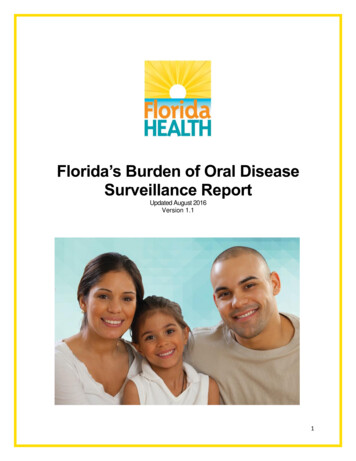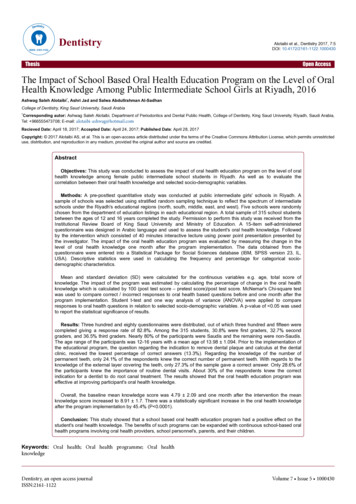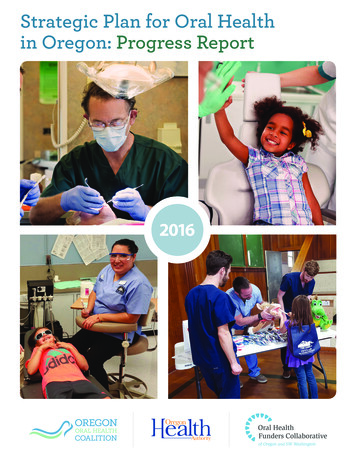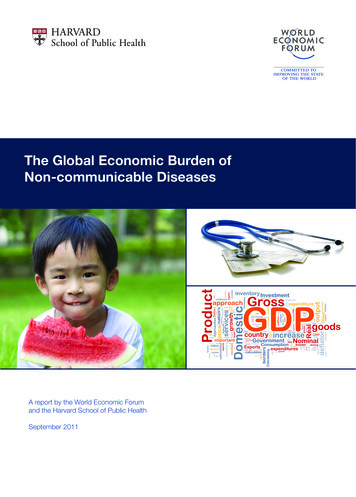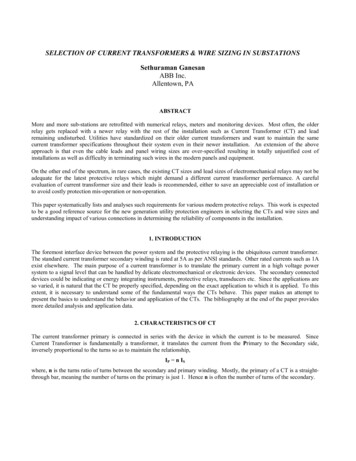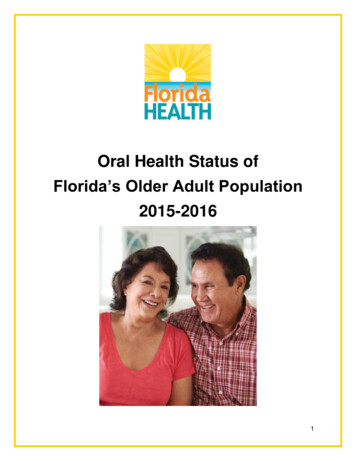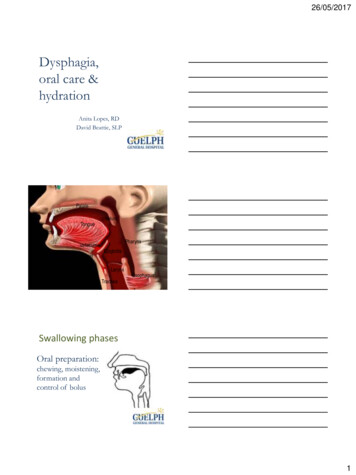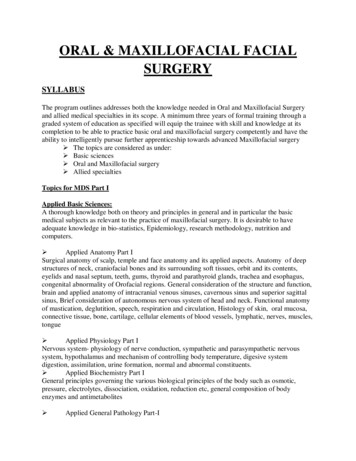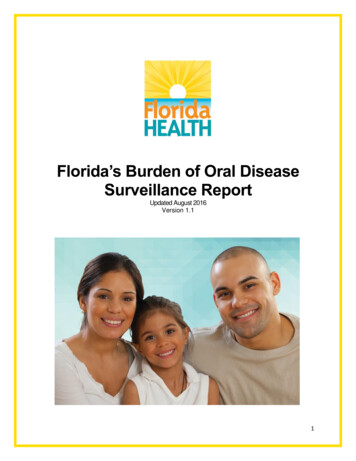
Transcription
Florida’s Burden of Oral DiseaseSurveillance ReportUpdated August 2016Version 1.11
AcknowledgementsPrimary Author:Abigail Holicky, MPHOral Health Epidemiologist, Public Health Dental ProgramPlanning and Implementation:Abigail Holicky, MPHPrevious Position: Council of State and Territorial Epidemiologists(CSTE) Applied Epidemiology Fellow, Bureau of Family HealthServicesDonna Solovan-Gleason, PhD, RDHGhasi Phillips-Bell, ScD, MSSenior Maternal and Child Health Epidemiologist, Bureau of FamilyHealth ServicesKris-Tena Albers, ARNP, CNMContributors:Public Health Dental Program, Bureau of Family Health ServicesChristina Vracar, DA, MPHEdward Zapert, DMDJennifer Wahby, MPHPhilippe Bilger, DDS, MPHSean Isaac, MPHShannon HarpOral Health Florida, Data and Sealant Action TeamsJill Herndon, PhDJo Ann Weatherwax, RDH, MSDHLilli Copp, BSScott Tomar, DMD, MPH, DrPHTami Miller, RDH, BSAgency for Health Care Administration, Medicaid Policy & QualityElizabeth Kidder, Assistant Deputy SecretaryTemple University Maurice H. Kornberg School of DentistryVinodh Bhoopathi, BDS, MPH, DScDSuggested Citation: Florida Department of Health, Public Health Dental Program. (2016). Florida’sBurden of Oral Disease Surveillance Report Version 1.1.The Public Health Dental Program: www.flhealth.gov/dental850-245-4333This study/report was supported in part by an appointment to the Applied Epidemiology Fellowship Programadministered by the Council of State and Territorial Epidemiologists (CSTE) and funded by the Centers for DiseaseControl and Prevention (CDC) Cooperative Agreement Number 1U38OT000143-03.2
Table of ContentsIntroduction . 5Executive Summary . 6List of Tables, Figures and Maps . 8Tables . 8Figures . 8Maps . 9State and National Objectives .10State .10National .11Healthy People 2020 .12The Burden of Oral Disease .15The Prevalence of Disease and Unmet Needs .15Children .15Adults.22Florida’s Vulnerable Populations .23Pregnant Women .23Special Health Care Needs .24Older Adults .25Poverty .27Societal Impact of Oral Disease.28Economic Impact of Oral Disease.29Risk and Protective Factors .30Community Water Fluoridation .30Dental Sealants .31Preventive Visits .36Screening for Oral Cancer .39Tobacco Use and Control .39Oral Health Education .41Human Papillomavirus (HPV) .42Sugar-Sweetened Beverages Consumption .42Provision of Dental Services .44Dental Workforce Capacity and Diversity .443
Dentists .44Dental Hygienists .45Utilization of Dental Care .46Children .46Adults.47Dental Medicaid and State Children’s Health Insurance Programs .50Community and Migrant Health Centers and other State, County and Local Agencies .51Conclusions .53Data Source Table .55References .574
IntroductionOral health is vitally important to overall health and well-being. Oral health is much more thanjust healthy teeth. Oral health is a state of being free from chronic mouth and facial pain, oraland throat cancer, oral sores, birth defects, periodontal disease, tooth decay and tooth loss, andother disease and disorders that affect the oral cavity.1 Good oral health also includes the abilityto carry on basic human functions such as chewing, swallowing, speaking, smiling, and singing.These functions are critical in our communication with others and interaction with the world.Research has shown a link between poor oral health and diabetes, heart and lung disease,stroke, respiratory illnesses, and adverse birth outcomes including the delivery of pre-term andlow birth weight infants. Changes in the mouth often are the first signs of problems elsewhere inthe body, such as infectious diseases, immune disorders, nutritional deficiencies, and cancer.Maintaining good oral and physical health requires a multi-faceted approach including a healthydiet, proper exercise, access to health care professionals, and public health initiatives such asfluoridated community water and preventive dental services including dental sealants. Dentaldisease is largely preventable through effective health promotion and dental disease preventionprograms. Collaborative partnerships among individuals, communities, health care providersand governing bodies are necessary to achieve optimal oral health in Florida.This surveillance report summarizes the most current information available on the burden of oraldisease in Florida. As Florida is a large and diverse state, this report also highlights groups andregions in our state that are at highest risk for oral health problems and discusses keypreventive initiatives currently utilized in Florida to prevent dental diseases and provide accessto dental care information across the state. The goal of this surveillance report is to quantify theoral health burden in Florida and to help guide programmatic and policy efforts to prevent andtreat oral diseases to enhance the quality of life for all Floridians.1“Oral Health,” n.d.5
Executive SummaryThe Florida Department of Health’s (Department) Public Health Dental Program looks towardsthe future with great expectation for progress in oral disease prevention and partnering withother agencies, programs, organizations, and stakeholders to address the dental diseaseburden in Florida. This document serves as a foundational review of surveillance data portrayingthe current status of oral disease across the life span of Florida’s population groups.Collaboration among public and private organizations in examining the data and developing aplan ensures the best results for improving the oral health status of Florida’s population.Most oral disease is preventable, however, disparities in the prevalence of dental disease existsfor specific populations in Florida. Lack of access to preventive dental measures, such asscreenings, dental sealants, and water fluoridation, and barriers to dental care creates inequitiesfor children and older adults who carry the burden of oral disease in the state. While Florida hasprogressed in recent years in conducting oral health surveillance, expanding public healthdental services, and increasing the percentage of population served with fluoridated water, oralhealth continues to be a priority for improving the overall health status of Floridians.First time oral health surveillance projects of third grade children, Head Start children and olderadults were conducted from 2013-2016 to assess the oral health status of these populationsacross Florida. Rates for untreated decay varied disproportionately across racial/ethnic groupswith highest rates seen in non-Hispanic Black third graders followed closely by Asian children.The presence of dental sealants also revealed racial/ethnic disparities with rates for nonHispanic Black, Hispanic, Asian and Multi-racial third grade children ranging between 7-15%lower than for non-Hispanic White children. Untreated decay rates for Head Start childrenrevealed similar results with rates of early childhood caries highest for Hispanic children anduntreated decay highest among non-Hispanic Black children. Lastly, preliminary results fromthe Older Adult Oral Health Screening Project reveal a poor oral health status, with high rates ofuntreated decay, need for periodontal care, and early dental care need.Parent-reported data from a nationwide survey on the condition of their children’s teeth concurswith Florida’s oral health surveillance data results. Florida parents of non-Hispanic Whitechildren reported their children’s teeth in excellent condition compared to non-Hispanic Blackand Hispanic counterparts as only fair to good condition. Medicaid reports reveal that only 26%of Medicaid-eligible recipients under the age of 21 received dental services in 2014, furthersubstantiating socioeconomic disparities for children accessing dental services.Children with Special Health Care Needs (SHCN) experience many barriers in accessing dentalservices. Nearly 25% of these children reported not having a dental visit in the past year.Finding a dentist who treats SHCN children is often difficult with approximately 70% of surveyeddentists reporting they treat between one and twenty SHCN patients annually.Decay rates in children have been linked to the consumption of sugar sweetened beverages(SSB). The prevalence of SSB consumption among middle and high school students estimates6
that 23% and 22%, respectively, drink sodas one or more times per day. Prevention educationis warranted for addressing this dietary concern in school-aged children.Survey data from the Behavioral Risk Factor Surveillance System (BRFSS) reveals 50% ofFlorida’s adults have permanent tooth loss due to decay and gum disease. Prevalence of toothloss was highest for non-Hispanic Black adults and for persons with less than a high schooleducation and low socio-economic status. Survey results further indicate disparities in theutilization of dental services with 66% of non-Hispanic White adults having a dental visit in thepast year compared to 56% of Hispanic and non-Hispanic Black adults.Data on oral and pharyngeal cancer for adults living in Florida show an age-adjusted incidencerate of 12.5 per 100,000 and age-adjusted death rate of 2.6 per 100,000. Cancer rates arehighest among non-Hispanic White individuals and are higher for males than females. Thepreponderance of reported oral cancers are associated with smoking and tobacco use,excessive alcohol consumption and sun exposure. Florida offers extensive resources for cancercontrol through prevention and cessation programs provided by the Bureau of Tobacco FreeFlorida. Smoking rates continue to decline with less than 18% of adults reporting having usedtobacco products in the last thirty days. Smoking rates for middle school and high schoolstudents reveal 2% and 7.5% respectively, report smoking cigarettes in the past 30 days.Survey results of the 2013-2014 Dental Workforce Surveillance Report reveal there arecurrently 10,981 active dentists and 11,589 active dental hygienists in the state of Florida.Nearly 59% of dentists provide general services through solo dental offices while 34% belong togroup practices that offer specialty dental services. The remaining 7% provide primarily publichealth and preventive dental services through the Department’s local health offices in each ofFlorida’s counties, Federally Qualified Health Centers (FQHCs), military clinics and academicfacilities. Over 90% of dental hygienists work in general practice solo offices while only 5% workin public health settings and academic facilities. The Department’s Public Health DentalProgram is promoting cost-effective workforce models in school-based sealant programsthroughout Florida health access settings. The program entitled “Sealing Sunny Smiles acrossFlorida” implements a cost-effective workforce and service delivery model, providing dentalsealants for children at highest risk for dental caries.This document is the first comprehensive report on the burden of oral disease in Florida. Thereport highlights the oral health disparities that exist for specific populations and describes theresources and programming efforts essential for improving the oral health of Florida residents.The Public Health Dental Program and partnering organizations are continuing to make stridestoward the betterment of Florida’s oral health status while improving the overall health of thestate.7
List of Tables, Figures and MapsTablesTable 1. Florida State Health Improvement Plan (SHIP) 2012-2015, Oral Health Objectives . 10Table 2. Healthy People 2020 Oral Health Objectives, National and Florida Status . 12Table 3. Oral Health Status of Florida’s Third Grade Children Stratified by Free/ Reduced Lunch Program(FRLP) Status of School, 2013-2014 . 19Table 4. Oral Health Outcomes During Pregnancy, Florida PRAMS 2012-2013 . 23Table 5. Prevalence of Florida Adults Aged 18 Years and Older With a Teeth Cleaning, BRFSS 2010 . 38Table 6. Prevalence of Adults Aged 18 Years and Older who are Current Smokers, National and FloridaEstimates, BRFSS 2014 . 40Table 7. Prevalence of Florida Students (Grades 6-12) That Used Tobacco at Least Once in the Past 30Days, by Tobacco Product, Florida Youth Tobacco Survey . 41Table 8. Prevalence of Adults Aged 18 Year and Older With a Visit to the Dentist in the Past Year,BRFSS . 48Table 9. Florida Medicaid Services Areas and Corresponding Counties . 50Table 10. CMS 416 Dental Indicators, National and Florida Estimates, FY 2011-2015 . 53FiguresFigure 1. Condition of Child's Teeth, National and Florida Estimates, 2011-2012 . .15Figure 2. Prevalence of One or More Oral Health Problems among Florida Children by Race/Ethnicity,Florida, 2011-2012 .16Figure 3. Oral Health Status of Florida's Head Start and Early Head Start Children, 2014-2015 . .16Figure 4. Oral Health Status of Florida's Third Grade Population, by Race/Ethnicity, 2013-2014 .17Figure 5. Oral Health Status of Florida's Third Grade Population, by Race/Ethnicity, 2013-2014. . 18Figure 6. Orofacial Birth Defect Rates per 10,000 Live Births, National and Florida Estimates .21Figure 7. Orofacial Birth Defect Rates per 10,000 Live Births by Maternal Race/Ethnicity, Florida 20082012 .21Figure 8. Prevalence of Florida Adults Who Have Lost a Permanent Tooth, by Race/Ethnicity 2014 22Figure 9. Prevalence of Complete Tooth Loss among Florida Adults Aged 65 Years and Older, byRace/Ethnicity, 2014 .25Figure 10. Prevalence of Oral Health Indicators among Florida's Older Adults, 2015-2016 .26Figure 11. Prevalence of Florida Adults Who Have Lost a Permanent Tooth, by Annual Income 2014 .27Figure 12. Prevalence of Total Early and Periodic Screening, Diagnostic, and Treatment (EPSDT)Program Eligibles Receiving a Sealant on a Permanent Molar Tooth, National and Florida Estimates, FY2011-2015 .32Figure 13. Prevalence of EPSDT Eligibles Aged 6-9 Years Receiving a Sealant on a Permanent Tooth,National and Florida Estimates, FY 2011-2015 33Figure 14. Prevalence of EPSDT Eligibles Aged 10-14 Years Receiving a Sealant on a Permanent Tooth,National and Florida Estimates, FY 2011-2015 33Figure 15. Prevalence of Dental Sealants in Florida’s Third Grade Population, by Race/Ethnicity, 20132014 .33Figure 16. Prevalence of Dental Sealants in Florida's Third Grade Population, by Percent of SchoolParticipation in Free/Reduced Lunch Program, 2013-2014 34Figure 17. Prevalence of No Preventive Dental Visit in the Past Year among Children, National andFlorida Estimates 2011-2012 .36Figure 18. Prevalence of Total EPSDT Eligibles under 21 Years Receiving Any Preventive DentalServices, By State FY 2015 .37Figure 19. Prevalence of Total EPSDT Eligibles under 21 Years Receiving Any Preventive DentalService, National and Florida Estimates, FY 2011-2015 .388
Figure 20. Prevalence of Florida High School Students Who Drank Soda or Sports Drinks Once or Moreper Day, 2015 .43Figure 21. Gender of Dentists with Active License Practicing in Florida, 2013-2014 . 44Figure 22. Race/Ethnicity of Dentists with Active License Practicing in Florida, 2013-2014 . 44Figure 23. Ages of Dentists with Active License Practicing in Florida, 2013-2014 . 44Figure 24. Gender of Dental Hygienists with Active License Practicing in Florida, 2013-2014 .45Figure 25. Race/Ethnicity of Dental Hygienists with Active License Practicing in Florida, 2013-2014 45Figure 26. Ages of Dental Hygienists with Active License Practicing in Florida, 2013-2014. .45Figure 27. Prevalence of Any Dental Care among Florida Children, 2011-2012 46Figure 28. Prevalence of Total EPSDT Eligibles under 21 Years Receiving Any Dental or Oral HealthService, National and Florida Estimates, FY 20112015 . 47Figure 29. Prevalence of Florida Adults With Dental Visit in the Past Year, by Race/Ethnicity 2014 .47Figure 30. Percentage of Florida Adult Medicaid Enrollees with a Dental Service Utilization Claim, by Age,2010-2013 .49MapsMap 1. Florida’s Head Start Oral Health Screening Project Results by Region, 2014-2015 . 17Map 2. Florida’s Third Grade Oral Health Screening Project Results by Region, 2013-2014 .20Map 3. Dental Special Projects Initiative Funded Counties, State Fiscal Year 2016-2017 . .28Map 4. Percent of Florida’s Population on Community Water Systems Receiving Optimally FluoridatedWater by County, 2015) 30Map 5. County Health Department School-Based Sealant Programs, June 2016 . 36Map 6. Florida Health Professional Shortage Areas for Dental Care by County, 2016 .529
State and National ObjectivesStateThe Department works to protect, promote, and improve the health of all people in Floridathrough integrated state, county, and community efforts. The Department is also responsible formonitoring the state’s health. The Public Health Dental Program (PHDP) within the Division ofCommunity Health Promotion and the Bureau of Family Health Services, leads theDepartment’s efforts to improve and maintain the oral health of all persons in Florida. The PHDPhas four primary functions:1.2.3.4.Provide a statewide direction for policy related to oral health issuesPromote and administer oral health education and preventive dental programsCollect and analyze oral health dataSupport the provision of direct dental care services through the Department’s localhealth offices and other public and private organizationsThe PHDP has met many state and national objectives to improve and maintain the oral healthof all persons in Florida. Florida’s State Health Improvement Plan (SHIP) includes enhancingaccess to preventive, restorative, and emergency oral health care.2Collaborative strategies encompass revising and implementing Florida’s State Oral HealthImprovement Plan (SOHIP), promoting integration between the oral healthcare system andother health care providers, including information sharing, education for medical providers onpreventive dental health services, more effective reimbursement, and incentives for improvingaccess to oral health services and revision of Medicaid reimbursement rules; assessing currentand future practitioner needs via re-licensure surveys of dentists and dental hygienists toascertain geographic distribution of practitioners and types of practices; and promotinginnovative oral health care delivery practice models.A summary of SHIP objectives and their current status, as of December 2015 is provided below:Table 1. Florida State Health Improvement Plan (SHIP) 2012-2015, Oral Health C4.2.1By Dec. 31, 2015,increase thepercentage of adultswho report havingvisited a dental clinicin the past year from59.8% to 61.8%.By Dec. 31, 2015,reduce thepercentage of adultswho report havingpermanent teethremoved because oftooth decay or gumAdults whoreporthavingvisited adental clinicin the pastyearAdults thathave hadanypermanentteethextractedAC4.2.22BaselineAll 1.9%(2014)All adultsBRFSS49.8%(2012)50.4%(2014)In progressCompleted“Florida State Health Improvement Plan 2012-2015,” 201210
Table 1. Florida State Health Improvement Plan (SHIP) 2012-2015, Oral Health initiondisease from 49.8%to 47.0%,By Dec. 31, 2015,increase thepercentage ofMedicaid childrenreceiving dentalservices from 23.4%in 2010 to 25.9%.By Dec. 31, 2015,increase thepercentage ofMedicaid eligible sixto nine year oldchildren who havereceived a sealanton one molar toothfrom 7.0% in 2010 to9.5%.By Dec. 31, 2015,increase the numberof CHDs FQHCs, orother local entitiesparticipating inschool health orother types ofcommunity-basedsealant programsfrom 11 in 2010 to35.By Dec. 31, 2015,increase thepercentage of theFlorida populationserved bycommunity watersystems withoptimally fluoridatedwater from 78.7% in2008 to tDataStatusTotalMedicaideligiblesreceivingany dentalservicesTotalMedicaidindividualseligible forEPSDT for 90continuousdaysAll Medicaideligibles forEPDST for 90continuousdays aged 6 –9 etedN/AN/APHDPand (2010)35(2014)CompletedNo. ofindividualsreceivingfluoridatedwater fromcommunitywatersystemsNo. ofindividualsreceivingwater )CompletedTotalMedicaideligiblesaged 6 - 9yearsreceiving asealant on apermanentmolar toothNationalThe national push for oral health awareness was highlighted in Oral Health in America: A Reportof the Surgeon General. This report alerted Americans to the importance of oral health in theirdaily lives.3 Issued in May 2000, the report detailed how oral health is promoted, how oraldiseases and conditions are prevented and managed, and what needs and opportunities exist toenhance oral health. The report’s message highlighted that oral health is essential to generalhealth and well-being and can be achieved. However, several barriers hinder the ability of someAmericans to attain optimal oral health. The Surgeon General’s report concluded with a3“Oral Health in America,” 200011
framework for action, calling for a national oral health plan to improve quality of life andeliminate oral health disparities.Individual states develop an oral health plan based on a set of measurable and achievableobjectives focusing on key indicators of oral disease burden, oral health promotion, and oraldisease prevention. National oral health indicators developed as part of Healthy People 2020, acontinuation of Healthy People 2010, provides a comprehensive, nationwide health promotionand disease prevention agenda. Most core public health functions, such as assessment andpolicy development, occur at the state level, thus state level oral health plans with uniqueindicators are necessary.Healthy People 2020The overarching goal of the Healthy People 2020 oral health objectives is to prevent and controloral and craniofacial diseases, conditions, and injuries, and improve access to preventiveservices and dental care.4 The seventeen measurable national oral health objectives, asoutlined by Healthy People 2020, address a number of areas for public health improvement,including the need to: Increase awareness of the importance of oral health to overall health and well-being.Increase acceptance and adoption of effective preventive interventions.Reduce disparities in access to effective preventive and dental treatment services.The target, desired direction, and current status of the Healthy People 2020 oral healthobjectives for the nation and Florida are summarized in Table 2.Table 2. Healthy People 2020 Oral Health Objectives, National and Florida StatusHealthy People 2020 ObjectiveTarget (%)Oral Health of Children and AdolescentsOH-1: Dental caries experience1.1: Children aged 3-5 years30.01.2: Children aged 6-9 years49.01.3: Children aged 13-15 years48.3OH-2: Untreated dental decay2.1: Children aged 3-5 years21.42.2: Children aged 6-9 years25.92.3: Children aged 13-15 years15.3Oral Health of AdultsOH-3: Untreated dental decay3.1: Adults aged 35-44 years25.03.2: Adults aged 65-74 years15.43.3: Adults aged 75 years and older 34.1OH-4: Permanent tooth loss4.1: Adults aged 45-64 years with68.8one or more permanent toothextracted4.2: Adults aged 65-74 years who21.6have lost all their natural teeth4DesiredDirectionNational (%)Florida (%) 27.9A57.7A53.4ANot Available43.1MNot Available 11.7A21.5A11.4A20.8N23.4MNot Available 24.9A14.8A37.9BNot AvailableNot AvailableNot Available 30.2A59.8O 13.1A10.5O“Healthy People 2020”, 201512
Table 2. Healthy People 2020 Oral Health Objectives, National and Florida StatusHealthy People 2020 ObjectiveTarget (%)DesiredDirection National (%)Florida (%)OH-5: Periodontal (gum) disease11.547.1CNot Availableamong adults aged 45-74 yearsOH-6: Oral and pharyngeal cancers 35.8 31.2DNot Availabledetected at earliest stageAccess to Preventive ServicesOH-7: Children, adolescents, and49.0 42.1ENot Availableadults who used the oral healthcare system in the past yearOH-8: Low-income children and33.2 34.6ENot Availableadolescents who received anypreventive dental service in the pastyearsOH-9: School-based health centers with an oral health component9.1: School-based health centers26.5 24.1FNot Availablewith dental sealants9.2: School-based health centers11.1 10.1FNot Availablewith dental care9.3: School-based health centers32.1 29.2FNot Availablewith topical fluoride
utilization of dental services with 66% of non-Hispanic White adults having a dental visit in the past year compared to 56% of Hispanic and non-Hispanic Black adults. Data on oral and pharyngeal cancer for adults living in Florida show an age-adjusted incidence highest among non-Hispanic White individuals and are higher for males than females. The


